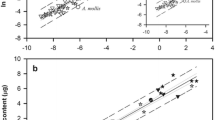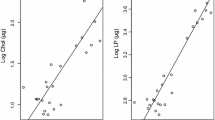Abstract
The lipid/fatty acid composition of marine fish eggs and larvae is linked with buoyancy regulation, but our understanding of such processes is largely restricted to species with pelagic eggs. In this study, we examined developmental changes in the lipid/fatty acids of eggs and embryos of Pacific cod (Gadus macrocephalus), a species that spawns demersal eggs along coastal shelf edges, but as larvae must make a rapid transition to the upper reaches of the water column. Adult Pacific cod were collected in the Gulf of Alaska during the spawning season and eggs of two females were artificially fertilized with sperm from three males for each female. The eggs were subsequently reared in the laboratory to determine (1) how lipids/fatty acids were catabolized during egg and larval development, and (2) whether lipid/fatty acid catabolism had measurable effects on egg/embryo density. Eggs incubated at 4°C began hatching after 3-weeks and continued to hatch over a 10-day period, during which there was a distinct shift in lipid classes (phospholipids (PL), triacyglycerols (TAG), and sterols (ST)) and essential fatty acids (EFAs: 22:6n-3 (DHA), 20:5n-3 (EPA), and 20:4n-6 (AA)). In the egg stage, total lipid content steadily decreased during the first 60% of development, but just prior to hatch we observed an unexpected 2–3-fold lipid increase (~6–9 μg individual−1) and a significant drop in egg density. The increase in lipids was largely driven by PL, with evidence of long-chained fatty acid synthesis. Late-hatching larvae had progressively decreasing lipid and fatty acid reserves, suggesting a shift from lipogenesis to lipid catabolism with continued larval development. Egg density measures suggest that lipid/fatty acid composition is linked to buoyancy regulation as larvae shift from a demersal to a pelagic existence following hatch. The biochemical pathway by which Pacific cod are apparently able to synthesize EFAs is unknown, therefore representing a remarkable finding meriting further investigation.







Similar content being viewed by others
References
Allen EE, Bartlett DH (2002) Structure and regulation of the omega-3 polyunsaturated fatty acid synthase genes from the deep-sea bacterium Photobacterium profundum strain SS9. Microbiology 148:1903–1913
Bajpai P, Bajpai PK (1993) Eicosapentaenoic acid (EPA) production from microorganisms: a review. J Biotechnol 30:161–183
Bell MV, Batty RS, Dick JR, Fretwell K, Navarro JC, Sargent JR (1995) Dietary deficiency of docosahexaenoic acid impairs vision at low light intensities in juvenile herring (Clupea harengus L.). Lipids 30:443–449
Berg OK, Hendry AP, Svendsen B, Bech C, Arnekleiv JV, Lohrmann A (2001) Maternal provisioning of offspring and the use of those resources during ontogeny: variation within and between Atlantic salmon families. Funct Ecol 15:13–23
Brodeur RD, Rugen WC (1994) Diel vertical distribution of ichthyoplankton in the northern Gulf of Alaska. Fish Bull 92:223–235
Budge SM (1999) Fatty acid biomarkers in a cold water marine environment. Dissertation, Memorial University of Newfoundland
Cetta CM, Capuzzo JM (1982) Physiological and biochemical aspects of embryonic and larval development of the winter flounder Pseudopleuronectes americanus. Mar Biol 71:327–337
Cook HW (1996) Fatty acid desaturation and chain elongation in eukaryotes. In: Vance DE, Vance JE (eds) Biochemistry of lipids, lipoproteins and membranes. Elsevier Science, Amsterdam, pp 129–152
Copeman LA, Laurel BJ (in review) Experimental evidence of fatty acid limited growth and survival in Pacific cod (Gadus macrocephalus) larvae. Mar Ecol Prog Ser
Copeman LA, Parrish CC, Brown JA, Harel M (2002) Effects of docosahexaenoic, eicosapentaenoic, and arachidonic acids on the early growth, survival, lipid composition and pigmentation of yellowtail flounder (Limanda ferruginea): a live food enrichment experiment. Aquaculture 210:285–304
Cossins AR, Lee JA (1985) The adaptation of membrane structure and lipid composition in cod. In: Gilles R (ed) Circulation, respiration, and metabolism. Springer, Berlin
Cossins AR, Friedlander MJ, Prosser CL (1997) Correlations between behavioural temperature adaptations of goldfish and the viscosity and fatty acid composition of their synaptic membranes. J Comp Physiol 120:109–121
Evans RP, Parrish CC, Zhu P, Brown JA, Davis PJ (1998) Changes in Phospholipase A(2) activity and lipid content during early development of Atlantic halibut, Hippoglossus hippoglossus. Mar Biol 130:369–376
Ferron A, Leggett WC (1994) An appraisal of condition measures for marine fish larvae. Adv Mar Biol 30:217–303
Finn RN, Fyhn HJ, Evjen MS (1995a) Physiological energetics of developing embryos and yolk- sac larvae of Atlantic cod (Gadus morhua). I. Respiration and nitrogen metabolism. Mar Biol 124:355–369
Finn RN, Henderson RJ, Fyhn HJ, Evjen MS (1995b) Physiological energetics of developing embryos and yolk-sac larvae of Atlantic cod (Gadus morhua). II. Lipid metabolism and enthalpy balance. Mar Biol 124:371–379
Frank KT, McRuer JK (1989) Nutritional status of field-collected haddock (Melanogrammus aeglefinus) larvae from southwestern Nova Scotia: an assessment based on morphometric and vertical distribution data. Can J Fish Aquat Sci 46(Suppl. 1):125–133
Fyhn HJ, Finn RN, Reith M, Norberg B (1999) Yolk protein hydrolysis and oocyte free amino acids as key features in the adaptive evolution of teleost fishes to seawater. Sarsia 84:451–456
Garcia AS, Parrish CC, Brown JA (2008) A comparison among differently enriched rotifers (Brachionus plicatilis) and their effect on Atlantic cod (Gadus morhua) larvae early growth, survival and lipid composition. Aqua Nutr 14:14–30
Hunt GL, Stabeno P, Walters G, Sinclair E, Brodeur RD, Napp JM (2002) Climate change and control of the southeastern Bering Sea pelagic ecosystem. Deep Sea Res Part II 49:5821–5853
Hurst TP, Cooper DW, Scheingross JS, Seale EM, Laurel BJ, Spencer ML, Duffy-Anderson J (2009) Combining laboratory and field observations to model vertical movements of larval Pacific cod (Gadus macrocephalus): effects of ontogeny, temperature, and light. Fish Ocean 18:301–311
Klovach NV, Rovnina OA, Kol’stov DV (1995) Biology and exploitation of Pacific cod Gadus macrocephalus) in the Anadyr-Navarin region of the Bering Sea. J Ichthyol 35:9–17
Ohkubo N, Sawaguchi S, Hamatsu T, Matsubara T (2006) Utilization of free amino acids, yolk proteins and lipids in developing eggs and yolk-sac larvae of walleye pollock Theragra chalcogramma. Fish Sci 72:620–630
Oppen-Berntsen D, Helvik J, Walther B (1990) The major structural proteins of cod (Gadus morhua) eggshell and protein crosslink during teleost egg hardening. Dev Biol 137:258–265
Parrish CC (1987) Separation of aquatic lipid classes by Chromarod thin-layer chromatography with measurement by Iatroscan flame ionization detection. Can J Fish Aquat Sci 44:722–731
Pitcher TJ, Hart PJB (1982) Fisheries ecology. Croom Helm, London 414
Riis-Vestergaard J (2002) Energy density of marine pelagic fish eggs. J Fish Biol 60:1511–1528
Riley P, Skirrow G (1975) Chemical oceanography. Academic Press, London, pp 56–74
Ronnestad I, Fyhn HJ (1993) Metabolic aspects of free amino acids in developing marine fish eggs and larvae. Rev Fish Sci 1:239–259
Saborido-Rey F, Kjesbu OS, Thorsen A (2003) Buoyancy of Atlantic cod larvae in relation to developmental stage and maternal influences. J Plank Res 25:291–307
Salze G, Tocher DR, Roy WJ, Robertson DA (2005) Egg quality determinants in cod (Gadus morhua L.): egg performance and lipids in eggs from farmed and wild broodstock. Aqua Res 36:1488–1499
Sargent JR, Henderson RJ, Tocher DR (1989) The lipids. In: Halver J (ed) Fish nutrition, 2nd edn. Academic Press, NY, pp 153–218
Sargent JR, McEvoy LA, Estevez A, Bell JG, Bell MV, Henderson RJ, Tocher DR (1999) Lipid nutrition of marine fish during early development: current status and future directions. Aquaculture 179:217–229
Tocher DR (2003) Metabolism and functions of lipids and fatty acids in teleost fish. Rev Fish Sci 11:107–184
van Raaij MTM, Breukel B-J, van den Thillart G, Addink ADF (1994a) Lipid metabolism of goldfish. Carassius auratus (L.) during normoxia and anoxia. Indications for fatty acid chain elongation. Comp Biochem Physiol 107b:75–84
van Raaij MTM, Breukel B-J, van den Thillart G, Addink ADF (1994b) Metabolism of 1-14C-acetate and 1-14C-leucine by anoxic goldfish (Carassious auratus)—evidence for anaerobic lipid synthesis. Physiol Zool 67:673–692
Whyte JNC, Clarke WC, Ginther NG, Jensen JOT (1993) Biochemical changes during embryogenesis of the Pacific halibut, Hippoglossus stenolepis (Schmidt). Aquac Fish Manag 24:193–201
Wiegand MD (1996) Composition, accumulation and utilization of yolk lipids in teleost fish. Rev Fish Biol Fish 6:259–286
Zhu P, Parrish CC, Brown JA (2003) Lipid and amino acid metabolism during early development of Atlantic halibut (Hippoglossus hippoglossus). Aquac Int 11:43–52
Acknowledgments
This project was supported in part with funding from the North Pacific Research Board (NPRB) grant #R0605. We thank Drs. Allan Stoner and Michael Davis for reviewing earlier drafts of this manuscript. Thanks also to Scott Haines, Paul Iseri and Michele Ottmar for providing assistance in the laboratory. Brian Knoth and Alisa Abookire assisted with egg collections in the field. Boat charters were kindly provided by Tim Tripp aboard the F/V Miss O. Thanks finally to J. Wells for the patient assistance and laboratory analysis of lipid classes and fatty acids. This manuscript is NPRB Publication # 245.
Author information
Authors and Affiliations
Corresponding author
Additional information
Communicated by U. Sommer.
Rights and permissions
About this article
Cite this article
Laurel, B.J., Copeman, L.A., Hurst, T.P. et al. The ecological significance of lipid/fatty acid synthesis in developing eggs and newly hatched larvae of Pacific cod (Gadus macrocephalus). Mar Biol 157, 1713–1724 (2010). https://doi.org/10.1007/s00227-010-1445-1
Received:
Accepted:
Published:
Issue Date:
DOI: https://doi.org/10.1007/s00227-010-1445-1




